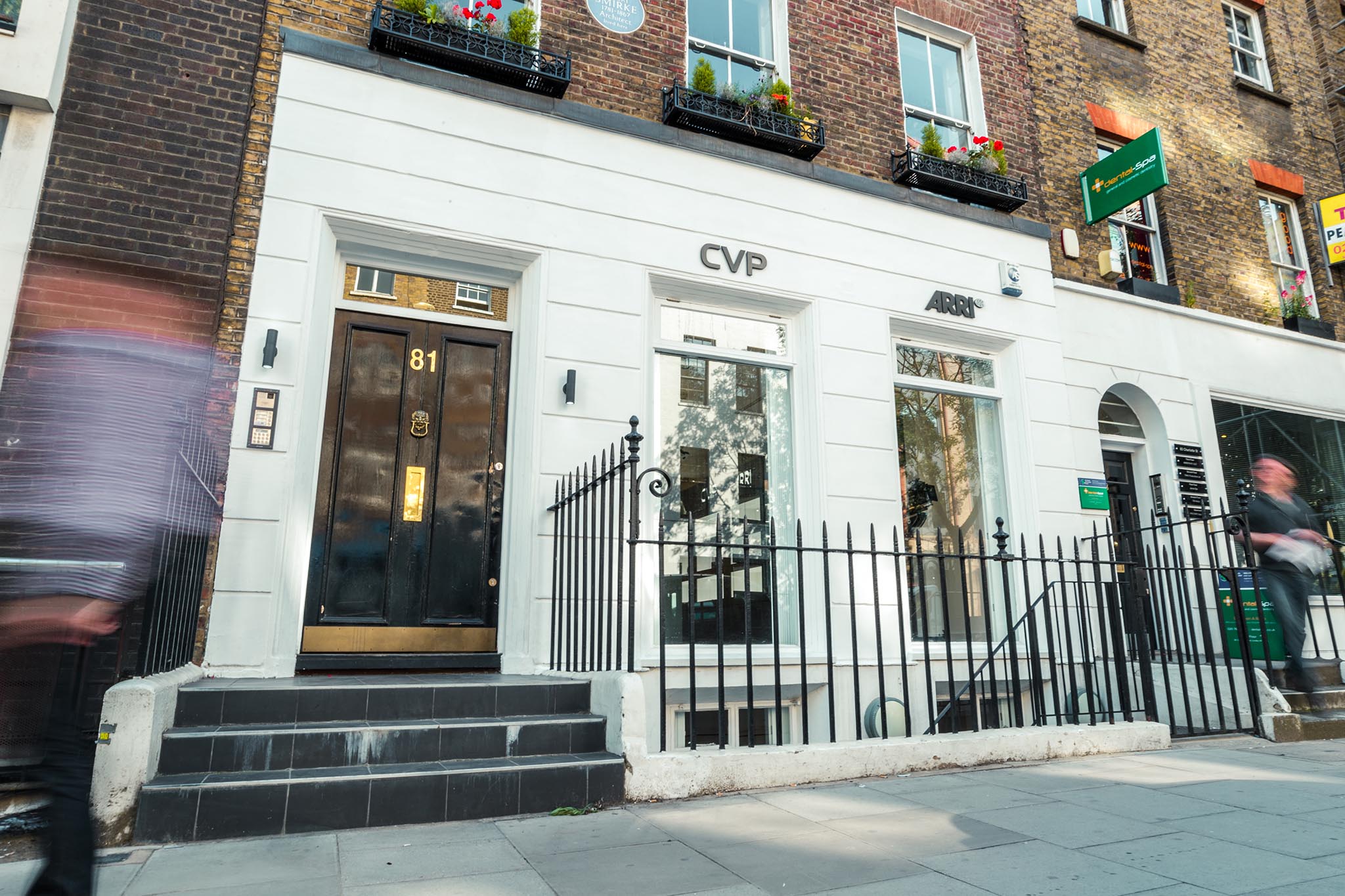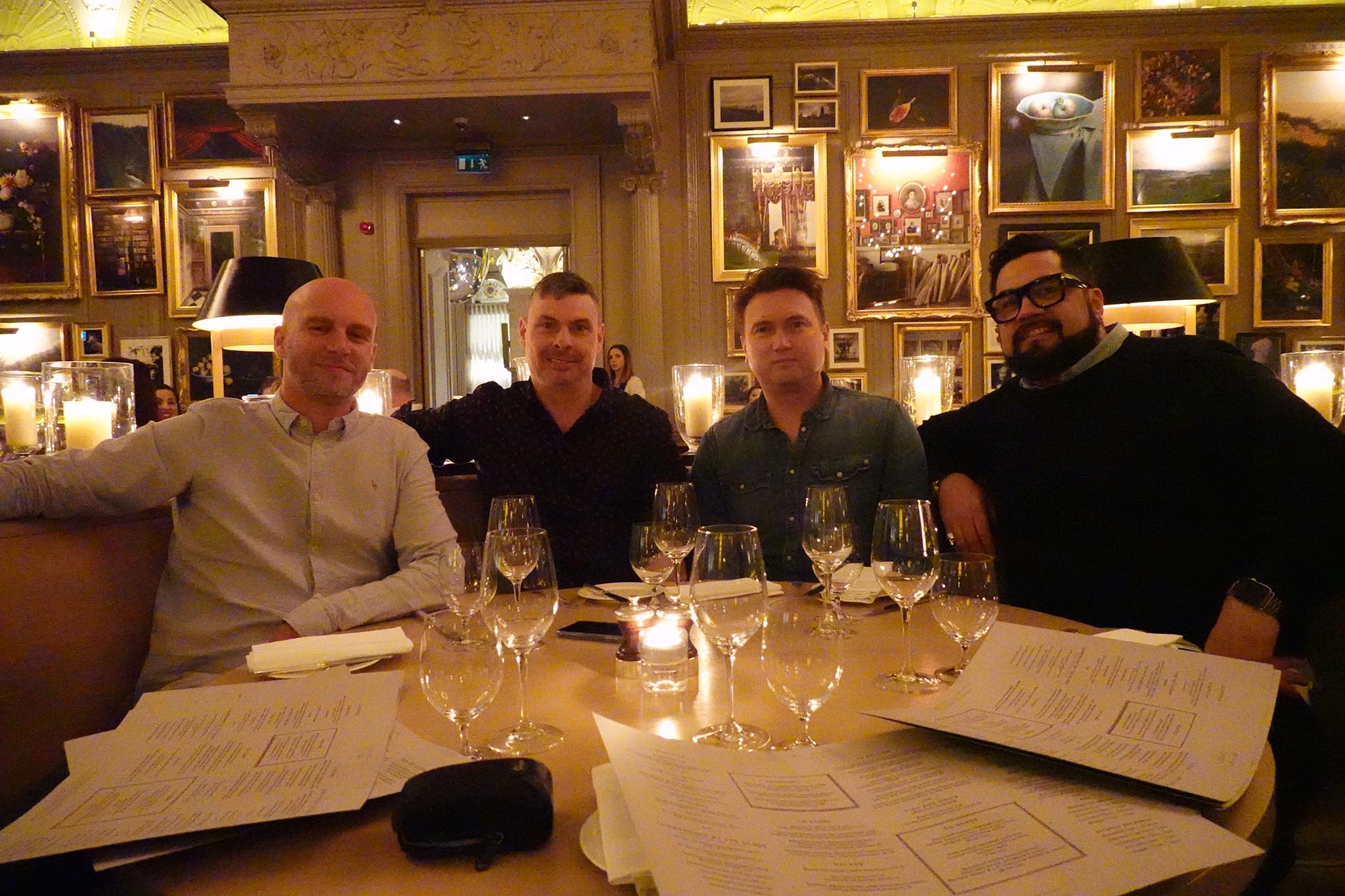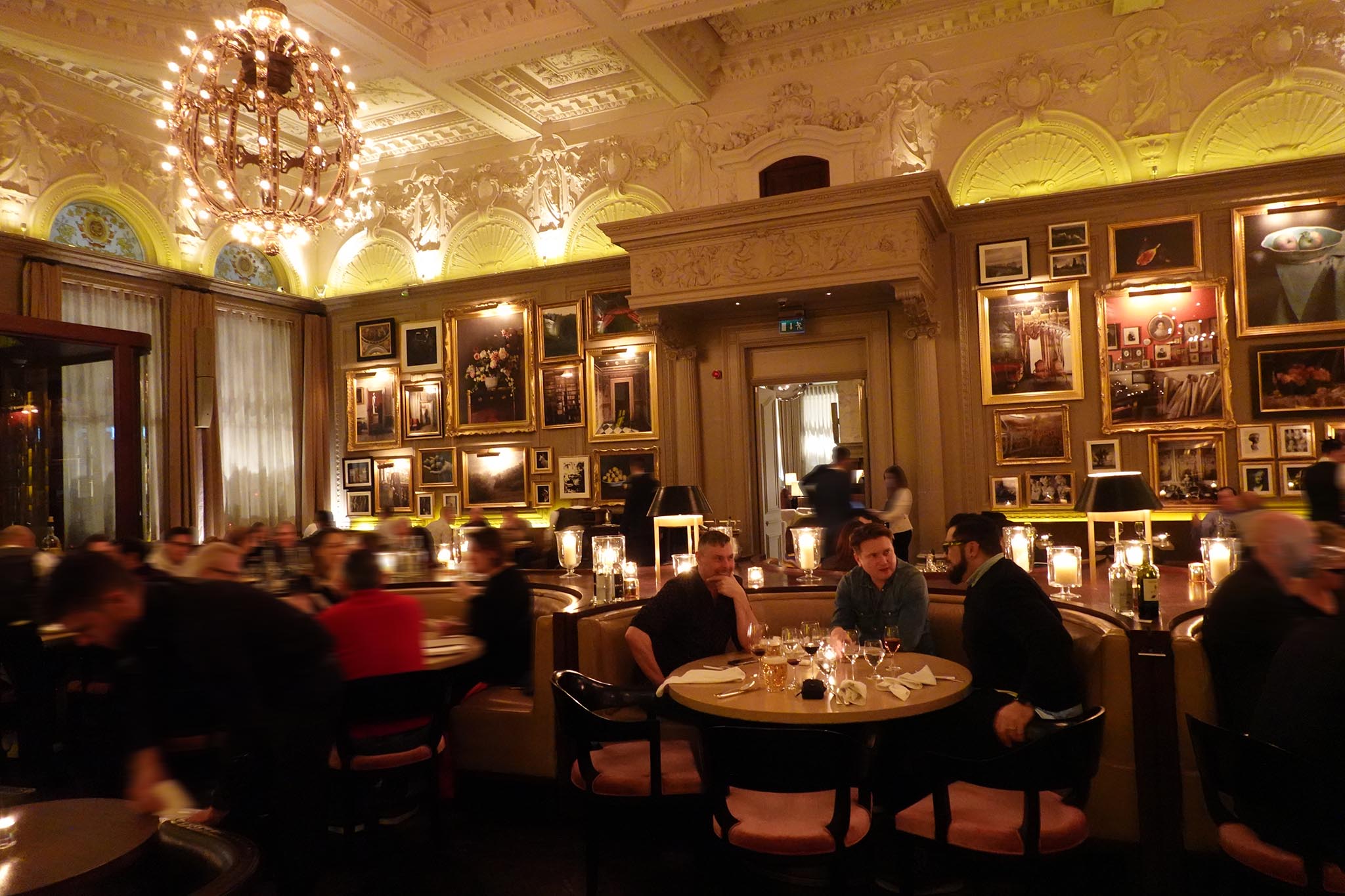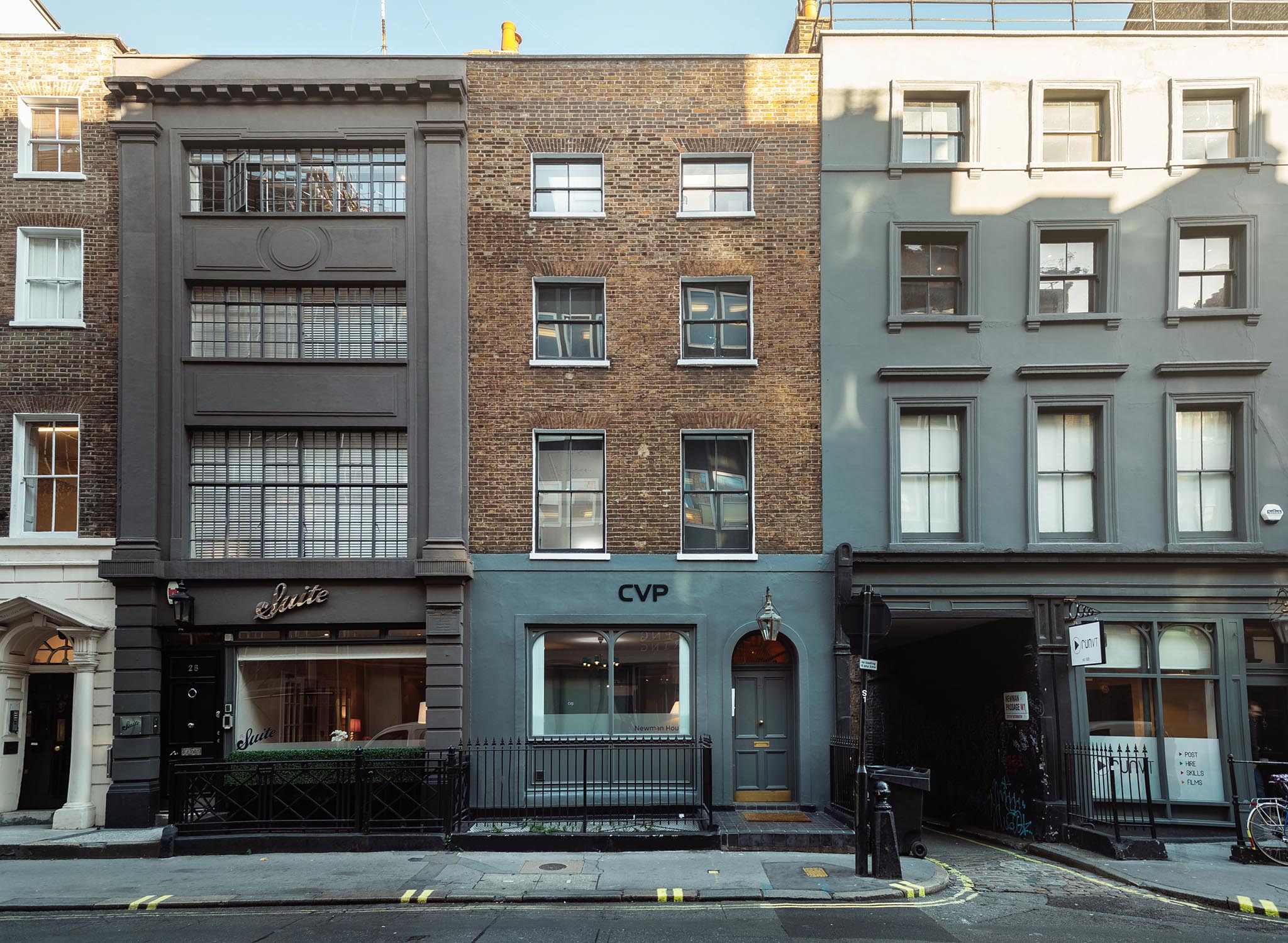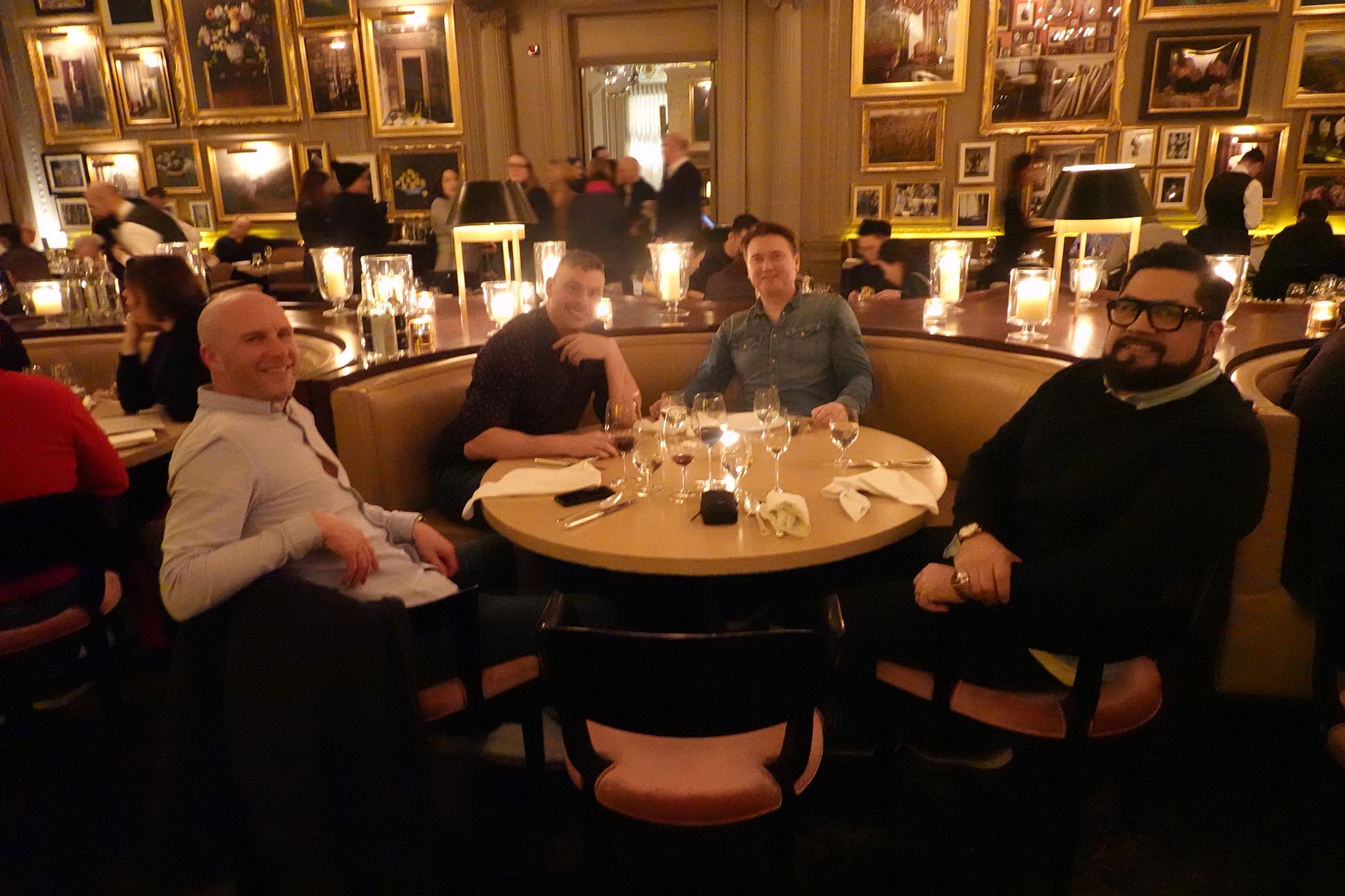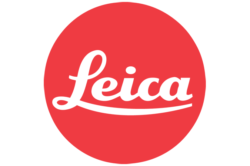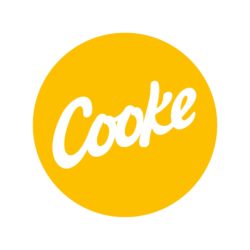Fitzrovia, London. January 28, 2020. Jon Fry, Darren Simpson, Yevgeny Subbotin, Aaron George and I met in the nicely appointed club at CVP Creative Space on Charlotte Street. As often happens in our world of moveable feasts, we soon adjourned to continue the discussion at Berners Tavern.
In a large elegant room festooned floor to ceiling with paintings, the menu included traditional British pork pie prepared tableside with showmanship, chargrilled Buccleuch Estate Scottish beef with triple cooked chips, battered Cornish haddock with crushed peas. As anyone familiar with this CVP and FDT cast of characters, the drinks and wine flowed copiously.
BSC Expo began a couple of days later, and then the world shut down. Although indoor dining is not on my list of recommended activities, we have updated this interview as things evolved. Production is busy in many places to meet the insatiable demand for films to stream.
Because there are two speakers with the same initials—Jon Fauer and Jon Fry, Jon in this interview refers to Jon Fry.
Jon Fauer: Would someone please tell us about the origins and history of CVP?
Jon Fry: I can start. CVP is probably 35 years old now. It began as Creative Video Productions, founded back then by Phil and Alison Baxter. Phil was an owner/operator, a jobbing cameraman on TV-am, a daytime news show in the UK. In addition to working as a news cameraman, he owned his own gear. But, at TV-am, he was not always shooting with his own gear. So Alison, his wife, rented out the kit that he owned when he wasn’t using it.
Smart lady.
Jon: I think they made as much money, perhaps more, by renting his gear than by his working as a cameraman. That evolved with Phil buying even more new equipment, renting it out, and then selling the used equipment. Eventually, they thought, “Why are we doing all this work through renting and working? We might as well buy new equipment and sell it.”
Where were they located?
Darren Simpson: Birmingham, in the Midlands. And I’m sure Phil had a production company as well.
Isn’t Birmingham the scary Peaky Blinders area?
Jon: I would hate to say that they were associated in any way. The company evolved into a reseller that did very well because they were quite quick to catch on to the trend of buying through the internet. They were largely the first proper transactional website in our industry in the UK.
Darren: Most definitely. That was around the mid 90s.
Jon: They took over the march from everyone else and were a good few years ahead of everyone else. They mainly dealt at the lower end and not the pro end of the market. They weren’t dealing with the BBC, ITV, the big rental companies or high-end produc-
So Phil bought Mitcorp?
Darren Simpson: CVP traded a lot with Mitcorp. All the dealers did that: they’d buy and sell from each other to help their own customers. It was a very different industry back then. Phil always wanted an in to what’s considered the broadcast market. He was mostly dealing with videographers who, to be fair, were the types of people buying stuff online anyway. But looking back, even a Sony Z1 Camcorder wasn’t the sort of thing you’d buy online. People hadn’t wrapped their heads around spending that much money on a camera and doing the transaction online. Back then, Mitcorp was the company with all the relationships with all the broadcasters and rental companies.
Jon: Then what happened was Creative Video Productions, which was a much smaller company, bought Mitcorp, which was the much larger company in terms of turnover. This was quite a sur- prise to the industry, but it was almost a match made in heaven. Normally, when you combine two companies, you add two 10s and it totals only 15 before it goes anywhere further. But because of the presence of Creative Video Productions online, together with the relationships of Mitcorp, the combination now meant that you put two 10s together and made 25, almost overnight, because of the complementary nature of the two companies.
Mark Forth was running Mitcorp as the sales director. He became the managing director of the combined companies. We all worked together from that point on. The company had circa 25 million turnover at that time. We’ve progressed from there to the posi- tion we’re in today, with an average of 110 million turnover. In the process, we’ve done nothing more than focus on selling gear, being better at what we do, and how we take that message to market.
Nice. Why don’t we talk about how each of you started. Shall we begin with Yevgeny? And where was Mitcorp located by the way?
Yevgeny: Mitcorp was where our headquarters are today, Brent- ford, West London, in the same offices. Darren was already working there. I joined Mitcorp in 2006, after being interviewed. I was one three people employed that day. I’m the only one left. The other two were fired within two months.
Aaron George: We tried firing him, but…
Yevgeny: They tried to fire me, and they couldn’t. I’ve always been in sales. Darren and I worked together at Mitcorp, under Mark, doing sales. and Jon Fry used to be our account manager at Sony.
I didn’t know that.
Yevgeny: Jon was the bright star at Sony within Europe. Jon joined Mitcorp in 2008.
Yev, where were you before Mitcorp?
Yevgeny: I was working for another company 100 meters away, selling computers. I can’t remember how, but somebody from Mitcorp came to buy a computer from me. They liked me and then they sent a secret shopper to barrage me with difficult questions.
They sent a what?
Yevgeny: A secret shopper.
Aaron: To test him out.
Yevgeny: Apparently, I handled myself okay and so they employed me.
Secret agent. Interesting. That’s a good story.
Yevgeny: I don’t know if it’s true or not. I’ve been told that.
How did you learn about the motion picture business?
Yevgeny: It was on the job training, totally. When I started, I didn’t know the difference between a BNC cable and an XLR. Actually, Darren was the one who taught me the most.
Darren Simpson: I told him to make sure he sells an XLR cable with each of his microphones, basically. Make sure it’s complete and it works. Make sure people don’t come back saying something is missing.
Darren, can you tell us how you started?
Darren: Well I came over from Australia in 2003. I’m from Melbourne originally where I worked in the industry. My dad owned a company in Melbourne that was a Sony, Panasonic and AVID reseller. I arrived in London basically looking for a job. I stayed in a hostel with other backpackers and spoke to many resellers who didn’t employ me. Three months later, Miller, the Australian brand of tripods and heads, recommended me to Mitcorp. They hired me to do showroom sales and things like that. I was more what we would call a technical consultant in sales to start with, but I was nowhere near technical, that’s for sure. It was mainly to look after freelancers. There were only three of us salespeople at the time, and that was it.
In the beginning, they wouldn’t let me sell Digibeta or high-end products. I was maybe allowed to sell DVCAM. We were traditionally a broadcast reseller. Ultimately, our big entry into the cinema business was probably thanks to RED releasing the RED ONE. All of a sudden, RED brought out the RED ONE and many people were buying them online for $20,000. The cameras would be delivered to them at home where they quickly realized they needed lenses, baseplates, matteboxes, tripods and everything else to make the camera work.
They didn’t know those things in advance?
Darren: No. They’d open the box and say, “Expletive deleted, I need to buy some more stuff.” To be fair, that’s how our relation- ship started with ARRI. I worked a lot with Alan Piper, when he was at ARRI, before he ran RED in the UK. Lovely guy. I learnt so much from Alan over the years. He taught me loads about lenses and matteboxes, which were often even more complicated than they are today.
I would sell Ultra Primes to customers and then, I then would enjoy explaining matteboxes to them. That’s where our relation- ship with ARRI started. We sold loads of Ultra Primes because not many sales companies like ours sold 35mm lenses back then. The rental houses had them and vintage lenses weren’t so trendy in those days.
What about Cooke lenses?
Darren: It took us years to get a relationship with Cooke. They came afterwards, but at that stage, ARRI/ZEISS Ultra Primes were probably the most popular lenses we were selling.
Why did you leave Australia?
Darren: Lots of reasons. I was lucky that my sister lived just down the road from here. She managed a pub and had a room rent free. So I lived in Piccadilly Circus for the first 12 months that I lived here, rent free in a pub.
What more could you want?
Darren: I stayed. I love London. I originally intended to stay for only two years for the duration of my holiday working visa.
Aaron: It’s about time you went home.
Ha. Then why don’t we talk to the other Australian in the room and why he didn’t go home. Aaron, how did you get started at CVP?
Aaron: I joined two and a half years ago. I’ve been with CVP quite a short time relative to everybody else here. But I’ve known them for more than 10 years. When I was at ARRI we had a close re- lationship with CVP and we became quite good friends over the period.
At ARRI, I was Head of Service looking after cameras, lenses and accessories as well as lasers and scanners for most of Europe.
I remember you at ARRI. Why are you not Head of Service at CVP? Why are you now in customer service and sales?
Aaron: That’s a good question, Jon. I think it’s a test in time thing about service because you mostly hear issues and problems that people have. It’s rewarding to solve them, but after 12 years of dealing with that, I was looking for a bit of a change, a new scene, and these guys had always been chasing me for years to offer me a job.
Darren: He’s one of the people we’d see every year at every trade show and we always joked around about when he would be coming to work for us, because he’s a likable guy, isn’t he? And we like to employ people we like. It’s just the way that we work, we just joked about it for years.
Jon: I seem to remember we told ARRI we didn’t court him.
Darren: No, we only joked around about it, didn’t we?
Aaron: It just happened. It was 12 years and I was like, “No, never, never.” But then one year, personal circumstances changed. My wife got pregnant and I wanted to be a little closer to home than the hour and a half each way that I was driving. And then we were at IBC and they did their usual joking, hitting me up, “Come and work for us.” But this time I said yes, and they were like, “What?”
Darren: No, you turned around to me and said, “Mate, I’ll do whatever you want, but I’m not having anything to do with engineering,” and we said, “Oh, you do sales then.” You were like, “Oh yeah, OK.” Anyway, we all joked around about it at the time because it was quite late at night and we had quite a bit to drink by that stage. Then we all came back and spoke about it. It seemed like a pissed idea at the time, but actually it all stacked up.
Aaron: I had worked in every part of the business: on the creative side, rentals, and service. The only thing I hadn’t really done was sales. I was confident with the kit and the industry and it made sense maybe to try my hand at it, and do something different.
Darren: Let’s face it, what we do isn’t really sales per se. It’s more account management. It’s relationships and solving problems and building camera kits. Aaron is one of those personalities who is likable and very knowledgeable and everything else that goes with it. It made sense, really.
Jon: I did not attend IBC in Amsterdam that year because my wife was having a baby. So, I came into work after IBC to be informed by Mark, Darren and Yev that we’d employed Aaron. I said, “Oh, that’s cool. What’s he going to be doing?” They said, “Working for you in sales.” I was like, “Great. Do we really know whether or not he wants to do this,” and they said, “Well, we don’t know. You’d better give him a call.” So we did and it worked.
Aaron: I remember getting that call from Jon Fry about a week later. He asked, “Were you serious? Are you sure you want to do this?” I said, “Actually, yes. Shall we meet?”
And I’m forever grateful to you, Aaron, because you were the one who introduced me to CVP. So thank you.
Aaron: Pleasure. For me, it’s been great so far. Setting up the ARRI Creative Space at CVP here with the guys has been amazing and the job’s been extremely rewarding. I do more than just the sales. We organize and host a lot of events and workshops and it’s been pretty diverse.
Jon Fry, how did you get started? I didn’t know about Sony.
Jon: There are a number of stories. But we’ll go with the real one. My background is actually as an engineer.
For real?
Jon: Everybody has the same reaction. And most people don’t believe me. They believe I was a dolphin trainer or a biscuit designer. But nobody believes that I was an engineer. Seriously, I did a five-year apprenticeship with the UK government as an electronic engineer. I then got a job with Sony after leaving the Defense Re- search Agency to fix gear on the bench in Basingstoke, at Jays Close and other places. It worked out after three or four years that I was better at explaining to people why I hadn’t fixed their gear properly than I was at actually fixing their gear.
You can’t make this stuff up.
Jon: It made sense that perhaps I should be more customer facing than actually engineering. I did a little spell in systems integration at Sony—solution architecture and project management. It was good, but my attention to detail, if I’m completely honest, was not built for that, and eventually, I fell into sales. I worked at Sony for a number of years. Then I had a two-year sabbatical, for want of a better word, where I went and worked at Visual Impact, who at the time were the biggest UK resellers. In the late 90s and early 2000s, they were almost comparable to what CVP is today.
I worked there for a couple of years and then went back to Sony in sales looking after the channel, as it’s called. This entailed looking after resellers. I was the Sony sales and account manager for Mitcorp and CVP. So I developed a relationship with not only the Mitcorp guys but also the Creative Video Productions guys. When the two companies merged, it came as quite a shock to me because I always thought it might be Mitcorp buying Creative Video Productions and not the other way around. Then 10 years ago, in December 2009, I gave in much in the same way as Aaron and Yevgeny did and joined the dark side.
Were you recruited by CVP?
Jon: I was recruited, yes. I’d always had a very good relationship with the guys. I liked my career at Sony, but there’s always a ceiling to what you’re ever going to achieve within a certain company. I think I’d probably reached that point within Sony. Therefore, it was a natural progression to move into CVP. I was fortunate enough to join as Sales Director. It was a fairly stiff learning curve coming from a large corporation like Sony and then moving into a very quick, flexible, nimble company like CVP where you make a decision, it’s done, and then you move on to the next thing. It was challenging but very exciting and quite fulfilling. So that was the career for me.
At that time, CVP was still owned by Phil and Alison Baxter? And from what I understand, some of you bought the company?
Jon: We worked under Phil. The hierarchy, if you like, was Phil as the CEO, Mark as the managing director, myself as the sales director, and then a very flat structure with sales and engineering and everything all rolling up to either myself or Mark, but with Darren and Yevgeny at the time very much taking the sales lead.
When I joined the company there were 10 sales people. (There are 20 today.) In 2013, Phil Baxter passed away suddenly, unexpectedly. That left Alison as 100% owner of a company without necessarily wanting to own the company. I think they were probably considering an exit just before he passed away, and she did a very good job of holding the company together. We took the lead to make sure that the company pushed forward. I think we did a good job in the period from 2014 to 2017. Eventually, Alison thought she’d done what she needed to do and wanted to move on. We were offered the opportunity to complete an MBO, a management buyout.
We got together as a group of five individuals. Mansukh Kerai, our financial director, Mark Forth the managing director, Darren and Yevgeny as directors, and me as sales director. We put together a business plan, presented it to a number of banks and got funding and support from HSBC to buy the company in December 2017.
While the company was big, we felt there was a need to bring back the personality. I think we’ve achieved that. We’re more accessible. We understand our customers and the market better today than we did even two years ago.
If you consider our Newman Street location, the facility is good and it is well stocked with the latest kit. But more than that, it’s a place to enable clever people to demonstrate their talents because you can’t do it without the people. We’ve worked hard in building a very capable network of people like Aaron, Ivailo, Sam Measure and everybody else. If you’re in production in the UK, you prob- ably have worked with them.
Your staff is like a who’s who of the British industry.
Jon: A bit. Newman Street, the Creative Space with ARRI, and the other locations are nothing more than a tool set to enable us to put those people in front of our customers.
In an MBO, is the bank involved in your day-to-day business? How do they protect their loan?
Jon: The MBO enabled us to purchase the company. The bank leaves the management of CVP to us. Fundamentally they protect themselves by having faith in the business. It’s not an asset finance. It is faith in your ability to run a company and pay back a loan.
But the bank has certain guarantees?
Jon: Whenever you borrow money there are personal guarantees attached. But those personal guarantees would never cover the value attached to the loan for the business because probably no individual would be able to afford it. However, what they did have was faith in the company for which they were funding the buyout. They considered the business plan being presented, the people on board, our customer database, our supplier network and every- thing that sits around that. Fundamentally, I suppose the validity attached to how good the business is or was and could be, moving forward as a forecasted projection, is what the bank invested in.
The reason I asked is because many companies in our business are individual or family owned, and this is one of the few that had a management buyout. Other companies we know were funded by private equity firms.
Jon: You find, in this industry, a lot of companies introduce private equity or venture capitalist investment in the company, which, to be honest, is something we could have done. However, the downside is that you no longer necessarily control your own business. We wanted to have flexibility to do what we wanted to do. We didn’t want to change our identity in any way, shape or form. In fact, what we actually wanted to do was invest more in the business because we recognized there were opportunities that weren’t being fulfilled by others.
For example?
Jon: Now, being supported by the bank and having demonstrated that we are able to facilitate the loan that they’ve given us means that they’re quite happy to let us invest more into the business. Examples are the buildings in Charlotte Street and Newman Street, as well as investments in additional members of staff.
Yevgeny: When we bought the company, we had just over 100 staff. Now we are 148.
Jon: It’s a continued investment. I think it’s going to continue moving forward as we get more and more people on board to facilitate, fundamentally, the demands of the industry and the customers whom we listen to. None of this was necessarily our brainchild. It’s all about getting closer to our customers.
Darren: And moving the market, really. Finding out what the challenges are and trying to put together facilities to address them. It’s not more complicated than that.
Would you like to go through a day in the life of how the sales is done at CVP? How is your approach different or unique?
Darren: We’ve been quite lucky to have relationships with all the manufacturers. The difference is we slowly expanded our portfo- lio. We were traditionally a Sony reseller. All these other brands seemed to happen off the back of that. We developed strong rela- tionships with all the lens manufacturers, including Angénieux, Cooke, Leitz and ZEISS. It was similar with cameras: ARRI, Blackmagic, Canon, Panasonic, RED, and the others all evolved over these years. One of the unique things about CVP is that we can give good, unbiased opinion on almost anything.
We have a chat, consult and talk to them about what they’re shooting and what their application is. Then we create the rec- ommended package for them. We won’t be forcing VENICE or ARRI on them. It’s all about the best tool for them, but let them make the decision on what they want to use and give them the pros and cons of each, and with lens choices. There are so many lens choices. And then there are all the bits of metal, rigs and accessories to go around it. We’re quite unique in that we also have put a lot of investment into accessories over the years to be able to support the camera and lens systems. Where we’ve been quite strong is that we hold stock.
I remember Jon Fry explaining the concept of “just in time” to me. Our industry often buys equipment just in time as the production actually begins.
Darren: Yes. And I can’t think of many other companies who really keep stock—inventory—the way CVP does. Phil always used to say that he wanted to have stock ready to ship from his website. It’s like when you buy a pair of shoes online, you might be less concerned what price is if you know if it’s in stock, and you’ll buy it. Sure, there’s an element of price as well. But our industry has gotten more and more complicated as the years have gone on. The camera’s the camera, and then you’ve got so many additions to that camera—power, cables, lenses, tripods, recording media—all the things that go around it. To have everything in stock, with different options, and to have all that in stock to be able to deliver next day or within a couple of days, is very difficult to do.
It’s even difficult for many manufacturers to do that.
Darren: We try to think ahead and get behind the right technology at the time. If we think it is going to be popular, we’ll put it in stock.
Yevgeny: We’re not always right though. It can be risky business.
Darren: We do get it wrong sometimes, no doubt about it. But we’re lucky enough nowadays that we’ve got enough volume here to be able to always find a home for something eventually.
It would be difficult to replicate what we’ve created today anywhere else because it’s already volume driven in the first place, and as Jon mentioned, our industry is so last minute. As we know, whether it’s producers, production companies or rental houses, the amount of lead time after a job is awarded can be as short as two days before the crew starts testing. It happens all the time. I’m sure it happens in the US as well.
It’s all about having these tools to be able to deliver the order be- cause at the end of the day, if you can’t deliver, you lose a sale.
Jon: The other key to this is we do offer customers total peace of mind. While we have all the gear in stock, on the run up to the start of a film, during the six months that they’re thinking about the project, we’ve been involved with them. We’ve been working with them to make sure that they understand what the kit is. Then there is often, literally, the last minute drop because they’ve given us two days notice even though they’ve been talking about it for six months.
At the back end of all this, we have full-time engineers in Brentford to support and repair the equipment. After we’ve delivered the gear, in the unlikely event they have a problem, we can also fix it. We also have a very large fleet of demonstration equipment where, if push comes to shove, and we try to avoid it if we can because it’s not really our business, we can bail people out if there’s a problem. Again, this is where I think we’ve created a business that is very different. We’re not just about selling boxes. We’re about making sure that throughout the customer journey they’re looked after. We hold their hands.
Darren: Customers are buying a manufacturer’s product, as far as we’re concerned. Because we represent that manufacturer, we feel responsible. We supplied the equipment in the first place. We’ve created the obligation to be able to follow through. Whether it’s pre or post sales, we are able to support the customer all the way through.
Yev, if some new gear comes along, are you proactive and call your customers and tell them that you have something new that might be of interest, or do you wait for them to call you?
Yevgeny: We never wait. We always talk to our customers daily and they appreciate our reaching out. We inform and educate. I would also like to add that CVP is well known for being able to source hard to find things. Often, these are products that a lot of people have heard about, but not many have seen. Like vintage lenses or film equipment that is in demand at this particular mo- ment. We can do it, and we are pretty well known for it.
Tell us about the buildings at Newman Street and Charlotte Street and how they came about.
Jon: It was largely driven by us recognizing, through relationships with our customers, the need for change in the market. As Darren said, when things are as complicated as they are in our industry, it’s very difficult to make an entire decision on a purchase, or ev- erything that you might need within that purchase for a particular project, online. You need to come and try things out. It’s a bit like your analogy of a bespoke tailor on Savile Row. If you repre- sent 1000 brands like we do, and god knows how many products are on the website, you need to go to one place to be able to try all of the pieces together. The only place that we know of in the UK that’s anywhere near that is our Newman Street facility.
Charlotte Street came about mainly because we wanted to offer a place in central London that was more than just a showroom. It is where people can come to as a destination. It enables us to get closer to our customers. Whether it’s a networking event, a popup restaurant or a product demonstration, it is something that was dreamt up out of the fact that we were doing high-end ARRI demonstration days. It could have been a hands-on event or a training event, and it would run for one day. If you hire a facility in central London for one day, it’s very expensive. Then you get fairly low turnout because most of the people who wanted to come along to the ARRI demonstration were busy working. Charlotte Street is a permanent exhibition space, and often some of the events run for a week.
People will drop in when they’ve got time rather than saying, “I can’t make February the 22nd, therefore, I’m going to miss out, but I might be able to do the 25th.” So come along on the 25th. That really was the driver for doing this, and it’s evolved from that into a club with membership and everything else that goes with it. The facility’s used continually.
Darren: To be fair, last year we created our own festival, basically. It is called Kitfest, and we’re doing it again next year. It uses our two premises and another place next door to Newman Street. We had all the manufacturers here to display their new kit. It was a way to give back to the manufacturers as well, and the level of professionalism of the attendees was amazing. It wasn’t just a nor- mal trade show. We had probably 500 or 600 people—rental com- panies, DPs, Directors and crew.
Jon: And we don’t charge for stand space.
What about the future?
Jon: I think there is still an opportunity for progression and for us to become better at what we do. One of the things that we’ve learned through creating a very strong group of people that sit either within CVP or are friends of CVP, is that we’re probably moving on from being what is largely considered as product experts to becoming technology experts. That is quite a broad brush, but I think we’ve demonstrated that to some degree.
Consider the Lens Coverage and Camera Comparison Tool, a phenomenal online tool that is the result of a huge amount of work by Sam Measure. It is not a product demonstration. While it shows a lot of cameras and lenses, it demonstrates the technology. I think we have the knowledge and expertise in-house now to push forward in 2021 and develop additional tools that are useful for our industry.
If we want to drive our industry forward, we’ve got to give people the knowledge and tools to become better at what they do. One of the things that we’re doing is to give the industry tools so that they can make decisions easier and the lens tool is an example of that.
What about training?
Jon: I’d love to think that we can do all of that. If we can develop training courses or opportunities and it’s something that can be included as part of a CV, that would be great for people who are trying to get their first job or as they’re trying to move up the ladder. They’re trying to progress with their careers. I think there’s an opportunity. People have spent fortunes attending training courses, and at the end of it, there’s often nothing to really certify them ever having done that. I think, again, we’ve got an initiative to try and make that happen.
You mentioned the website. Do most people order through the website or direct, person to person?
Jon: Our business is between 15% and 20% online. The rest is ac- count managed face-to-face. We’re a different model from what most people expect. In a perfect world, I would love everybody who finds out about CVP, whether through social media, via our website or at a trade show, to end up walking through our doors. They would develop a relationship with a sales person, meet one of our technical consultants and end up having a conversation with one of our engineers. If any customer has that experience, we at CVP, have a much better opportunity of retaining that custom- er. Anybody who buys online will do that for a couple of reasons. Mainly because we’ve got it in stock…
Aaron: Or it’s late at night or a weekend….
Jon: We’re competitive in terms of pricing. But the next time they want to buy something, they’ll probably still go through a search engine and find us again, but that’s not good enough. We’ve put a lot of time, effort, and energy in creating what I believe is a very valuable sales process, and I’d love everybody to end up talking to us on the phone because that way they will get an appreciation of just what we have available to them to make their purchase easier.
Darren: It’s better when you pick the phone up and they remem- ber you, isn’t it? It might go like this: “I need to buy a monitor.” I’ll offer a suggestion. “Oh great. Send me a quote.” Bang, and they order it and job done. They want to speak to someone. It’s an advantage to know someone within a company rather than just being another number.
Jon: It’s opposite to the way the majority of sales or retail happens today. Everybody wants to move away from the high street. Everybody wants to push everything through an online portal because it’s a cheaper route to market. But by separating yourself, how on earth are you supposed to understand the true wants and needs of a customer? They don’t tell you about their job require- ments online, and that’s the challenge. When an industry like ours is so much in need of understanding technology and has a definite requirement to get hands on, up close and personal, to gather an opinion that is credible, that’s where we add value. We’re cred- ible because we’re brand agnostic. That’s what it’s got to be about for me.
Darren: It’s taking everything back to the old school again, as well. That’s what Newman and Charlotte Street are about. You can come and touch and feel it.
Thank you very much. I look forward to this discussion being continued. And to getting together again in a nice restaurant like Berner’s Tavern.
(This is a “reprint” from August 2020 FDTimes issue 105.)

